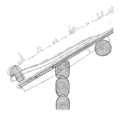Green roof
(Redirected from Green roofs)
A Green roof or living roof is a roof of a building that is partially or completely covered with vegetation and a growing medium, planted over a waterproofing membrane. It may also include additional layers such as a root barrier and drainage and irrigation systems. Green roofs serve several purposes for a building, such as absorbing rainwater, providing insulation, creating a habitat for wildlife, and helping to lower urban air temperatures and mitigate the heat island effect.
Types of Green Roofs
There are generally two types of green roofs: extensive and intensive.
- Extensive green roofs are designed with a thin layer of soil and are primarily intended to grow hardy, drought-resistant plants such as sedums. They are lightweight, require minimal maintenance, and are often not accessible to the public.
- Intensive green roofs, on the other hand, are thicker and can support a wider variety of plants, including trees and shrubs. They are heavier, require more maintenance, and can include features such as walkways and benches for public or private use.
Benefits
Green roofs provide numerous environmental, economic, and social benefits. They can:
- Reduce energy consumption by providing natural insulation,
- Improve air quality by filtering pollutants and carbon dioxide,
- Extend the lifespan of roofing materials by protecting them from the elements,
- Create peaceful retreats for people and habitat for species at risk,
- Manage stormwater by absorbing rain, thus reducing runoff and decreasing the risk of flooding.
Challenges
Despite their benefits, green roofs face challenges in implementation. These include:
- Higher initial costs compared to traditional roofs,
- Structural considerations, as buildings must be able to support the additional weight,
- Maintenance requirements, especially for intensive green roofs,
- Limited knowledge and awareness among architects, builders, and property owners.
Installation and Maintenance
The installation of a green roof involves several steps, starting with an assessment of the roof's structural capacity. Following this, a waterproof membrane is installed, along with root barriers, drainage systems, and irrigation systems if necessary. The choice of plants is critical and depends on the climate, roof conditions, and type of green roof.
Maintenance varies significantly between extensive and intensive roofs. Extensive green roofs may only require occasional weeding and fertilization, while intensive roofs need regular watering, feeding, and pruning.
Global Examples
Green roofs have been implemented worldwide, with notable examples including the Ford Motor Company's River Rouge Plant in Dearborn, Michigan, the California Academy of Sciences in San Francisco, and the Vancouver Convention Centre in British Columbia, Canada. These projects highlight the versatility and adaptability of green roofs to different climates and building types.
Conclusion
Green roofs represent a sustainable building practice that can significantly contribute to environmental conservation, urban biodiversity, and quality of life. As urban areas continue to grow, the integration of green roofs into architectural designs offers a promising path towards more resilient and sustainable cities.
This article is a environment-related stub. You can help WikiMD by expanding it!
Transform your life with W8MD's budget GLP-1 injections from $125.
W8MD offers a medical weight loss program to lose weight in Philadelphia. Our physician-supervised medical weight loss provides:
- Most insurances accepted or discounted self-pay rates. We will obtain insurance prior authorizations if needed.
- Generic GLP1 weight loss injections from $125 for the starting dose.
- Also offer prescription weight loss medications including Phentermine, Qsymia, Diethylpropion, Contrave etc.
NYC weight loss doctor appointments
Start your NYC weight loss journey today at our NYC medical weight loss and Philadelphia medical weight loss clinics.
- Call 718-946-5500 to lose weight in NYC or for medical weight loss in Philadelphia 215-676-2334.
- Tags:NYC medical weight loss, Philadelphia lose weight Zepbound NYC, Budget GLP1 weight loss injections, Wegovy Philadelphia, Wegovy NYC, Philadelphia medical weight loss, Brookly weight loss and Wegovy NYC
|
WikiMD's Wellness Encyclopedia |
| Let Food Be Thy Medicine Medicine Thy Food - Hippocrates |
Medical Disclaimer: WikiMD is not a substitute for professional medical advice. The information on WikiMD is provided as an information resource only, may be incorrect, outdated or misleading, and is not to be used or relied on for any diagnostic or treatment purposes. Please consult your health care provider before making any healthcare decisions or for guidance about a specific medical condition. WikiMD expressly disclaims responsibility, and shall have no liability, for any damages, loss, injury, or liability whatsoever suffered as a result of your reliance on the information contained in this site. By visiting this site you agree to the foregoing terms and conditions, which may from time to time be changed or supplemented by WikiMD. If you do not agree to the foregoing terms and conditions, you should not enter or use this site. See full disclaimer.
Credits:Most images are courtesy of Wikimedia commons, and templates, categories Wikipedia, licensed under CC BY SA or similar.
Contributors: Prab R. Tumpati, MD













